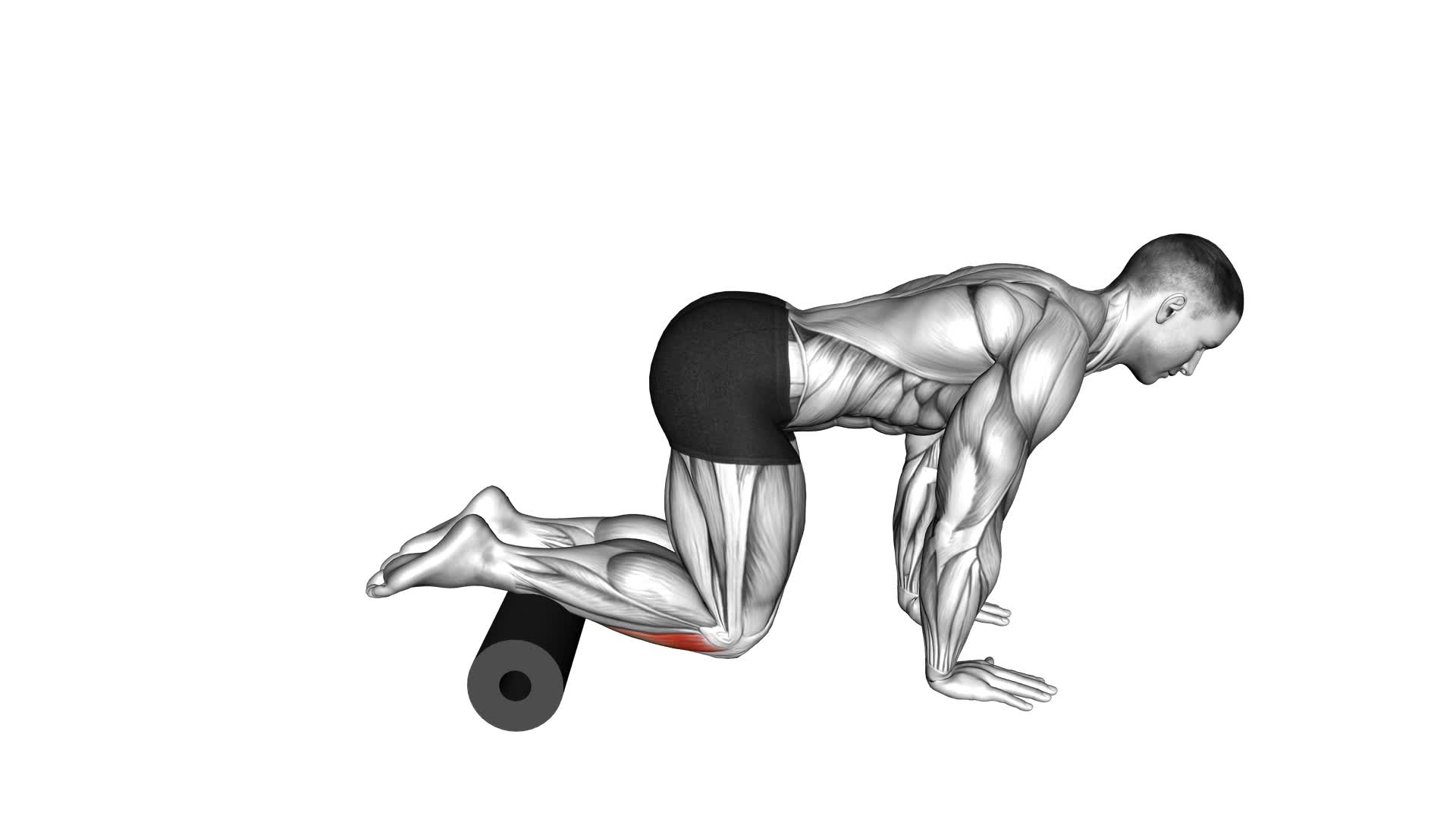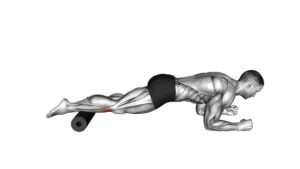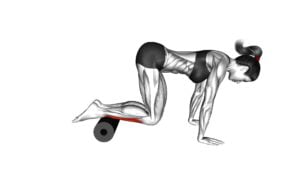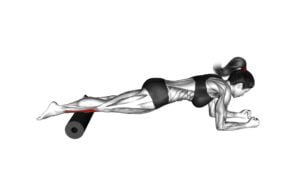Roll Tibialis Anterior – Video Exercise Guide & Tips

Are you looking to improve your lower leg strength and flexibility?
Watch This Exercise Video
In this video exercise guide, we'll show you how to roll your tibialis anterior muscle effectively. By using a foam roller or a massage ball, you can target this important muscle to help alleviate pain, prevent injuries, and enhance your athletic performance.
Get ready to learn the proper technique and discover advanced variations that will take your workout to the next level.
Let's roll!
Key Takeaways
- Rolling the Tibialis Anterior muscle can stretch and release tension in the muscle.
- Regular rolling can increase flexibility and range of motion in the ankle and foot.
- Rolling can promote faster recovery, reduce the risk of injuries, and alleviate muscle soreness and inflammation.
- Different rolling techniques and tools can target specific areas and provide targeted relief.
Benefits of Rolling Tibialis Anterior
To experience the benefits of rolling Tibialis Anterior, you should regularly incorporate this exercise into your fitness routine.
Rolling the Tibialis Anterior is an effective way to stretch and release tension in this muscle, which is located in the front of your lower leg. Before you begin rolling, it's important to stretch to prepare your muscles and prevent injuries.
Start by stretching your calves and ankles, as these areas are interconnected with the Tibialis Anterior. This will help to increase flexibility and range of motion.
When rolling, it's crucial to use proper technique and prevent injuries. Make sure to apply gradual pressure and avoid any sharp or sudden movements. Take your time and focus on each area, rolling back and forth to target different parts of the muscle.
By following these guidelines, you can reap the benefits of rolling Tibialis Anterior without the risk of injury.
Now that you understand the importance of stretching and how to prevent injuries, let's move on to preparing for the exercise.
Preparing for the Exercise
Before you start the exercise, it's important to properly prepare for rolling the Tibialis Anterior. Proper preparation exercises and warm-up techniques can help prevent injury and maximize the effectiveness of the exercise.
To prepare for rolling the Tibialis Anterior, it's recommended to perform some warm-up exercises to increase blood flow and loosen up the muscles in the area. One effective warm-up technique is ankle circles. Simply sit on the ground or a chair and lift one leg off the floor. Slowly rotate your ankle in a circular motion, first clockwise and then counterclockwise. Repeat this for about 10-15 repetitions on each leg.
Another helpful warm-up exercise is toe taps. Stand up straight and lift one foot off the ground. Keeping your leg straight, tap your toes on the floor in front of you, and then tap them behind you. Repeat this motion for about 10-15 taps on each leg.
Proper Technique for Rolling
Now that you're ready to start rolling, let's discuss the points you need to keep in mind for proper technique.
Rolling offers several benefits, such as increasing blood flow and reducing muscle tension. However, it's important to avoid common mistakes like rolling too quickly or applying excessive pressure.
Lastly, it's recommended to incorporate rolling into your routine regularly to maximize its effectiveness.
Benefits of Rolling
You can experience numerous benefits by using proper technique when rolling the Tibialis Anterior muscle. Here are some discussion ideas on the benefits of rolling:
- Different types of rolling techniques: Rolling can be done using various tools such as foam rollers, massage balls, or even your hands. Different techniques, such as cross-friction or myofascial release, can target specific areas and provide targeted relief.
- Improved flexibility and mobility: Rolling the Tibialis Anterior muscle helps to release tension and tightness, allowing for greater range of motion in the ankle and foot. This can be particularly beneficial for athletes or individuals who participate in activities that require quick and agile foot movements.
- Enhanced recovery and injury prevention: Rolling helps to increase blood flow and circulation, promoting faster recovery and reducing the risk of injuries. It also helps to break down scar tissue and adhesions, which can improve overall muscle function and prevent future injuries.
- Reduced muscle soreness: Rolling can alleviate muscle soreness by reducing inflammation and promoting the release of endorphins, which are natural pain-relieving chemicals in the body. This can help you recover faster and get back to your workouts or daily activities with less discomfort.
Common Mistakes to Avoid
To ensure proper technique and maximize the benefits of rolling the Tibialis Anterior muscle, it's important to avoid common mistakes that can hinder your progress and increase the risk of injury.
One common mistake to avoid isn't properly warming up before rolling. A proper warm-up is essential to prepare your muscles for the rolling exercise and prevent injuries.
Another mistake to avoid is applying too much pressure or rolling too quickly. Applying excessive pressure can cause discomfort or even injury, while rolling too quickly may not effectively target the muscle.
It's important to find a balance between applying enough pressure to feel the muscle being worked, and allowing the muscle to relax and release tension.
Recommended Rolling Frequency
To achieve optimal results and minimize the risk of injury, it's important to follow the recommended rolling frequency and use proper technique when rolling the Tibialis Anterior muscle. Here are some guidelines to help you roll effectively:
- Recommended Frequency: Aim to roll the Tibialis Anterior muscle at least 2-3 times a week to maintain flexibility and prevent tightness.
- Warm-up: Prior to rolling, warm up the muscle by performing light dynamic stretches or exercises to increase blood flow and prepare the muscle for the rolling session.
- Technique: Place the foam roller perpendicular to the muscle and apply gentle pressure. Slowly roll from the ankle to the knee, targeting any areas of tightness or discomfort.
- Duration: Spend 1-2 minutes rolling each leg, focusing on any trigger points or knots. Avoid rolling over bony prominences or joints.
Advanced Rolling Variations
Explore the advanced rolling variations for targeting the Tibialis Anterior muscle. To further enhance your foam rolling routine and maximize the benefits, it's important to incorporate rolling progressions and advanced foam rolling techniques. These variations will help you to effectively target and release tension in the Tibialis Anterior muscle.
One advanced rolling variation is the single leg rolling technique. Start by sitting on the floor with one leg extended in front of you. Place the foam roller under your calf muscle, just above the ankle. Slowly roll the foam roller up towards your knee, focusing on any areas of tightness or discomfort. Pause on these areas and apply gentle pressure for a few seconds before continuing the roll.
Another advanced technique is the cross friction rolling. This technique involves rolling the foam roller across the width of the Tibialis Anterior muscle. Start by placing the foam roller on the outer edge of your shin, parallel to the muscle fibers. Apply pressure and slowly roll the foam roller across the muscle, perpendicular to the fibers. This technique helps to break up scar tissue and adhesions, promoting better muscle function.
Incorporating these advanced rolling variations into your routine will provide a deeper and more targeted release for the Tibialis Anterior muscle. Remember to listen to your body and adjust the pressure and intensity of the roll accordingly.
Happy rolling!
Tips for Maximizing Results
To maximize your results when performing the roll tibialis anterior exercise, it's important to focus on proper form techniques. This includes maintaining a stable core, using controlled movements, and avoiding excessive pressure on the muscle.
Additionally, targeting the specific muscle groups involved, such as the tibialis anterior and surrounding muscles, will help you achieve a more effective workout.
Proper Form Techniques
For optimal results, focus on maintaining proper form while performing the roll tibialis anterior exercise. Here are some proper form techniques to help you maximize your results:
- Position yourself: Sit on the floor with your legs extended in front of you. Place the foam roller under your lower leg, just above your ankle.
- Engage your core: Keep your core muscles activated throughout the exercise to stabilize your body.
- Apply pressure: Use your hands to control the amount of pressure applied to the foam roller. Start with a moderate amount of pressure and increase or decrease as needed.
- Roll slowly: Move the foam roller up and down your lower leg, targeting the tibialis anterior muscle. Roll slowly and pause on any tight or tender spots.
Targeted Muscle Groups
To maximize your results, focus on targeting specific muscle groups while performing the roll tibialis anterior exercise. By engaging the tibialis anterior muscle, you can effectively strengthen and tone the front of your lower leg. This exercise is particularly beneficial for individuals who engage in activities that require repetitive ankle movements, such as running or jumping.
To effectively target the tibialis anterior, place the foam roller just below your knee and slowly roll it down towards your ankle. Apply gentle pressure and pause on any areas that feel tight or tender.
Effective Workout Strategies
You can maximize your workout results by implementing effective strategies. Here are four tips to help you get the most out of your workouts:
- Perform effective warm-up exercises: Before diving into your main workout, it's crucial to warm up your muscles and prepare them for the upcoming intensity. Incorporate dynamic stretches, such as leg swings and arm circles, to increase blood flow, loosen up your joints, and activate your muscles.
- Prioritize stretching: Stretching is often overlooked but plays a vital role in improving flexibility, preventing injuries, and enhancing performance. Include static stretches after your workout to lengthen and relax your muscles. Focus on the major muscle groups you targeted during your session.
- Vary your routine: Your body adapts to repetitive workouts, leading to plateaus in progress. Keep your workouts fresh and challenging by incorporating different exercises, adjusting weights and repetitions, or trying new training methods.
- Allow for proper recovery: Rest and recovery are essential for muscle growth and repair. Make sure to give yourself adequate time between workouts, prioritize sleep, and nourish your body with healthy foods to optimize recovery.
Common Mistakes to Avoid
One common mistake to avoid when performing the roll tibialis anterior exercise is neglecting to maintain proper form and alignment. Proper form techniques are crucial for maximizing the benefits of this exercise and preventing potential injuries.
One common mistake is allowing the feet to flop or roll inward during the exercise. This can put excessive stress on the tibialis anterior muscle and lead to strain or discomfort. To avoid this, make sure to keep the feet in a neutral position throughout the exercise.
Another mistake to avoid is using excessive pressure or force when rolling the muscle. Applying too much pressure can cause pain and discomfort, and may even lead to bruising or tissue damage. Instead, apply gentle and controlled pressure while rolling, allowing the muscle to relax and release tension gradually.
Lastly, it's important to avoid rushing through the exercise. Taking your time and moving slowly and deliberately will allow you to target the tibialis anterior muscle effectively and ensure proper engagement.
Frequently Asked Questions
How Often Should I Perform the Rolling Tibialis Anterior Exercise?
To maximize the benefits of the rolling tibialis anterior exercise, it's important to consider the frequency of your workouts. How often should you perform this exercise?
The answer depends on your fitness level and goals. Generally, it's recommended to incorporate this exercise into your routine 2-3 times per week. This frequency allows your muscles to recover and adapt to the movement, promoting strength and flexibility in the tibialis anterior muscle.
Can Rolling Tibialis Anterior Help Improve Ankle Mobility?
Rolling Tibialis Anterior exercise can be effective in improving ankle mobility. By targeting the tibialis anterior muscle, this exercise helps to strengthen and stretch the muscles around the ankle joint.
Improved ankle mobility can enhance your overall movement and stability, allowing you to perform activities with greater ease and reduced risk of injury.
Incorporating rolling Tibialis Anterior into your regular workout routine can provide significant benefits for your ankle mobility.
Are There Any Modifications or Alternatives for Individuals With Limited Knee Flexibility?
If you have limited knee flexibility, there are modifications and alternatives for you to consider.
When it comes to exercises like rolling the tibialis anterior, you may need to make adjustments to accommodate your knees. For example, you can try using a foam roller or massage ball to target the muscles without putting too much strain on your knees.
Additionally, you can explore other exercises that focus on ankle mobility and calf stretching, which can also help improve overall flexibility.
What Are Some Additional Exercises That Can Complement the Rolling Tibialis Anterior Exercise?
To complement the rolling tibialis anterior exercise, there are additional exercises for strengthening your calf muscles. These exercises include calf raises, where you lift your heels off the ground, and skipping, which involves jumping off one foot at a time.
Stretches for the lower leg muscles can also be beneficial. Examples include standing calf stretches, where you lean against a wall and stretch your calves, and seated toe stretches, where you flex your feet and pull your toes towards you.
Can Rolling Tibialis Anterior Help Prevent or Treat Shin Splints?
Rolling the Tibialis Anterior can be an effective exercise for preventing and treating shin splints. By targeting this muscle, you can improve its flexibility and reduce tension in the shin area.
However, it's important to note that stretching exercises alone may not be sufficient in preventing or treating shin splints. Wearing proper footwear that provides adequate support and cushioning is also crucial.
Incorporating both stretching exercises and appropriate footwear can maximize the effectiveness of preventing and treating shin splints.
Conclusion
In conclusion, rolling the tibialis anterior is a beneficial exercise that can help improve flexibility and reduce muscle tightness in the shin area.
By properly preparing for the exercise and using the correct technique, individuals can maximize their results and avoid common mistakes.
Advanced rolling variations can also be incorporated for added challenge.
Remember to follow these tips and techniques to effectively target the tibialis anterior and achieve optimal results.

Author
Years ago, the spark of my life’s passion ignited in my mind the moment I stepped into the local gym for the first time. The inaugural bead of perspiration, the initial endeavor, the very first surge of endorphins, and a sense of pride that washed over me post-workout marked the beginning of my deep-seated interest in strength sports, fitness, and sports nutrition. This very curiosity blossomed rapidly into a profound fascination, propelling me to earn a Master’s degree in Physical Education from the Academy of Physical Education in Krakow, followed by a Sports Manager diploma from the Jagiellonian University. My journey of growth led me to gain more specialized qualifications, such as being a certified personal trainer with a focus on sports dietetics, a lifeguard, and an instructor for wellness and corrective gymnastics. Theoretical knowledge paired seamlessly with practical experience, reinforcing my belief that the transformation of individuals under my guidance was also a reflection of my personal growth. This belief holds true even today. Each day, I strive to push the boundaries and explore new realms. These realms gently elevate me to greater heights. The unique combination of passion for my field and the continuous quest for growth fuels my drive to break new ground.



